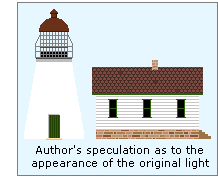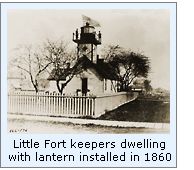|
Historical
Information After the construction of a private pier in 1841, vessels were finally able to make their way to shore, and in 1844 151 vessels made their way into Little Fort, delivering almost a million feet of lumber, 250 tons of merchandise and furniture, 758 barrels of salt, 650 barrels of flour, 145 barrels of pork and beef, and loading 66,000 bushels of wheat, 200 bushels of oats, 200 pounds of furs, 8,000 pounds of hides and 15 barrels of pork. Seeking federal assistance for harbor improvements, Illinois Congressman John Wentworth presented a petition from citizens in Illinois and Wisconsin on January 5, 1846 "praying an appropriation for the construction of a harbor and the erection of a light-house at Little Fort, on lake Michigan, in the State of Illinois." Congress appropriated $12,000 for harbor improvements that year, and followed-up with an additional appropriation of $4,000 in 1847 for the construction of a lighthouse to serve the new harbor. Stephen Pleasonton, the Fifth Auditor of the Treasury, was responsible for the nation's aids to navigation at this time, and with no maritime background, his administration was typified by fiscal tightness. It is an unfortunate fact that most of the lighthouses built under his administration were built at minimum cost, and construction suffered as a result. Such was to be the case with the Little Fort Light, which was built under contract on a bluff a half-mile to the north of the harbor in 1849. While we know that the station consisted of a brick tower and detached wood-frame keepers dwelling, we have as yet been unable to identify any further information about the structure.
In 1852, William B. Snowhook, the Collector and Superintendent of the Eleventh District under the newly formed Lighthouse Board, followed in Miller's footsteps and arrived in Little Fort while conducting his first inspection of the lights now under his supervision. Snowhook held no punches in his report, stating that he found the station to be "in dilapidated condition, and defective in every respect." Observing that the temporary repairs made by the prior administration had done little to stem the deterioration of the tower's exterior surface, he went on to describe how he found the bricks in some areas to have crumbled to a point where a full three inches of their surface had disintegrated. He also noted that the gallery floor was lower at its center than at its circumference, rain water was pooling on the floor and running into the lantern, damaging the iron of the lantern, stairs and the masonry within the tower. Estimating that a complete repair would cost $10,500, he recommended that an appropriation be sought for the necessary funds, but also made a recommendation that would lay the groundwork for the future lighting of the harbor. Two years earlier, Congress had passed a bill appropriating $15,000 for the construction of breakwaters at Little Fort under the supervision of the Army Corps of Topographical Engineers. Snowhook observed this work underway, and realizing that a light of some type would be needed at the extremity of these breakwaters to guide vessels into the harbor, proposed that an iron beacon light be constructed at the northern end on their completion, and that the existing Little Fort Light station be discontinued at that time, since it would no longer serve any real purpose. It would appear that Snowhook's recommendation was well received, since Congress only approved $1,000 for the Lighthouse Board in 1860 to keep the Little Fort Light shining, but appropriated $10,500 for the Army Corps of Engineers to construct an iron pierhead beacon on the end of the new breakwater upon its completion.
Subsequent changes and additions in the harbor plan continued to delay the completion of the breakwaters, and with the Little Fort keeper's dwelling continuing to serve as the only light for the harbor, 1867 saw the construction of new outbuildings at the station, followed by the replacement of the roof in 1870. Unbelievably, the arrival of 1880 found the Army Corps of Engineers still busy in the harbor, and without an apparent end in the work, it appeared that the "temporary" installation of the light atop the keeper's dwelling was fast becoming a permanent arrangement. Since the town of Waukegan was now encroaching on the station reservation on the bluff, a picket fence was constructed around the entire reservation to provide security. Finally, in 1898 the work on the
breakwaters was drawing to a close, and a temporary iron post supporting
a white lens lantern was erected at the outer end of the north
breakwater. With the construction of a small lamp cleaning building on
the pier to provide keepers with a protected area in which to perform
the constant maintenance required of the illuminating apparatus, this
new light was exhibited for the first time on the night of August 10,
1898. With this new light in service, the "temporary" Fifth Order light installed on the Little Fort
Keepers dwelling twenty years previous was permanently discontinued on December 31, 1889. |
 A year later, Henry B. Miller the Superintendent and
Inspector of Lights on Northwest Lakes, arrived in
Little Fort on July 18 while conducting his annual inspection of the
lights in his district. In his report to Pleasonton, he stated that while he found the keeper to be
conscientious and effective, he was dismayed with the condition in which
he found the tower. It appeared that the brick used in its constructed
was of inferior quality, being entirely too soft for use in such an
exposed location. In effect serving as a sponge, the brick was absorbing
moisture and subsequently flaking and cracking during the freeze / thaw
cycle of the area's harsh winters. Concerned that the deterioration had
advanced to the point that the entire structure needed re-facing with
hard brick to permanently stem the deterioration, he was also well aware
of the frugality under which the department was operated would make the
availability of such funds virtually impossible, and thus he proposed
that the sum of fifteen dollars be spent to effect a temporary repair
through the re-pointing of the masonry and whitewashing of the towers
exterior.
A year later, Henry B. Miller the Superintendent and
Inspector of Lights on Northwest Lakes, arrived in
Little Fort on July 18 while conducting his annual inspection of the
lights in his district. In his report to Pleasonton, he stated that while he found the keeper to be
conscientious and effective, he was dismayed with the condition in which
he found the tower. It appeared that the brick used in its constructed
was of inferior quality, being entirely too soft for use in such an
exposed location. In effect serving as a sponge, the brick was absorbing
moisture and subsequently flaking and cracking during the freeze / thaw
cycle of the area's harsh winters. Concerned that the deterioration had
advanced to the point that the entire structure needed re-facing with
hard brick to permanently stem the deterioration, he was also well aware
of the frugality under which the department was operated would make the
availability of such funds virtually impossible, and thus he proposed
that the sum of fifteen dollars be spent to effect a temporary repair
through the re-pointing of the masonry and whitewashing of the towers
exterior. With a mere $1,000 appropriation
available for repairs at Little Fort, the Eleventh District Engineer was forced to seek a
considerable less expensive alternative to keep the light shining until
the new breakwater lights' completion. Conducting a complete survey of
the station's structures, it was found that the keeper's dwelling was
still in excellent condition, and thus a wooden tower with a standard
octagonal cast iron lantern was constructed at the apex of its roof in
1860.
With the relocation of the lens from the old brick tower, the new
temporary Light was placed in service, and the crumbling brick tower was
demolished.
With a mere $1,000 appropriation
available for repairs at Little Fort, the Eleventh District Engineer was forced to seek a
considerable less expensive alternative to keep the light shining until
the new breakwater lights' completion. Conducting a complete survey of
the station's structures, it was found that the keeper's dwelling was
still in excellent condition, and thus a wooden tower with a standard
octagonal cast iron lantern was constructed at the apex of its roof in
1860.
With the relocation of the lens from the old brick tower, the new
temporary Light was placed in service, and the crumbling brick tower was
demolished.